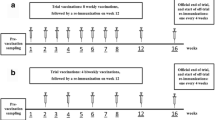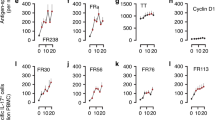Abstract
Introduction: An extended phase I trial was conducted in a total of 26 patients with ovarian cancer. The objectives were to assess the safety and tolerability of idiotypic vaccination using the murine monoclonal antibody HMFG1 (anti-MUC1), and to develop robust assays to monitor humoral immune responses generated against either the antibody or MUC1. Material and methods: All patients had undergone standard debulking surgery (where appropriate) and at least one regimen of platinum-based chemotherapy. Eligibility criteria included: (a) residual disease at the end of chemotherapy, (b) relapsed disease, and (c) pathologically confirmed second complete remission following salvage chemotherapy. Patients received a priming dose of 25 mg of HMFG1 either intravenously or intraperitoneally, followed by up to six intradermal doses of HMFG1 in 10% Alhydrogel at intervals of 1 month. The three dose levels were 0.5 mg, 1 mg and 5 mg. We devised modifications of published protocols for the measurement of anti-idiotypic and anti-MUC1 antibody responses and also extended the use of the IAsys resonant mirror biosensor to measure the kinetics of the idiotypic network response in these patients. Results: There were no serious adverse events at any dose level. The trial confirmed that all doses could be administered safely with minimal toxicity. No clinical responses were seen in patients with evaluable disease. ELISA for anti-idiotypic antibodies (Ab2) showed significant levels in patients who completed the protocol. There were no significant differences in the levels of Ab2 generated by the different doses of antibody. These results were confirmed by biosensor assays for Ab2, which also showed affinity maturation of the Ab2 response as patients progressed through the vaccination protocol. Biosensor assays also demonstrated no difference in the affinity of Ab2 generated by different booster doses of HMFG1. ELISA for anti-MUC1 antibodies showed less consistent results, with very small but statistically significant rises in anti-MUC1 signals seen in 38% of patients who completed the vaccination regimen. Discussion: The clinical endpoints of safety and tolerability were met. The assays developed for this project have shown reproducibility and may provide surrogate endpoints to assess vaccination for future trials. The use of similar biosensors may be of particular relevance for monitoring of humoral immune responses in other vaccine trials. The low levels of anti-MUC1 antibodies generated may correspond with the lack of clinical efficacy in the few patients with evaluable disease.





Similar content being viewed by others
References
Pettersson F, Creasman W, Shepherd J, Pecorelli S (1994) Annual report on the results of treatment in gynecological cancer. FIGO 22:38–40
McGuire WP, Hoskins WJ, Brady MF, Kucera PR, Partridge EE, Look KY, Clarke-Pearson DL, Davidson M (1996) Cyclophosphamide and cisplatin compared with paclitaxel and cisplatin in patients with stage III and stage IV ovarian cancer. N Engl J Med 334(1):1
Lambert HE, Rustin GJ, Gregory WM, Nelstrop AE (1993) A randomized trial comparing single-agent carboplatin with carboplatin followed by radiotherapy for advanced ovarian cancer: a North Thames ovary group study. J Clin Oncol 11(3):440
Taylor-Papadimitriou J, Burchell J, Miles D, Dalziel M (1999) MUC1 and cancer. Biochim Biophys Acta 1455:301
Miles D, Towlson K, Graham R, Reddish M, Longenecker B, Taylor-Papdimitriou J, Rubens R (1996) A randomised phase II study of sialyl-Tn and DETOX-B adjuvant with or withou cyclophosphamide pretreatment for the active specific immunotherapy of breast cancer. Br J Cancer 74:1292
Jerne N (1974) Towards a network theory of the immune system. Ann Immunol (Inst Pasteur) 125C:373
Taylor-Papadimitriou J, Peterson J, Arklie J, Burchell J, Ceriani R, Bodmer W (1981) Monoclonal antibodies to epithelium-specific components of the human milk fat globule membrane: production and reaction with cells in culture. Int J Cancer 28(1):17
Hird V, Maraveyas A, Snook D, Dhokia B, Soutter WP, Meares C, Stewart JS, Mason P, Lambert HE, Epenetos AA (1993) Adjuvant therapy of ovarian cancer with radioactive monoclonal antibody. Br J Cancer 68(2):403
Courtenay-Luck NS, Epenetos AA, Sivolapenko GB, Larche M, Barkans JR, Ritter MA (1988) Development of anti-idiotypic antibodies against tumour antigens and autoantigens in ovarian cancer patients treated intraperitoneally with mouse monoclonal antibodies. Lancet 2(8616):894
Mittelman A, Chen Z, Liu C, Hirai S, Ferrone S (1994) Kinetics of the immune reponse and regression of metastatic lesions following development of humoral anti-high molecular weight associated antigen immunity in three patients with advanced malignant melanoma immunized with mouse anti-idiotypic monoclonal antibody MK2–23. Cancer Res 54:415
Kwak LW, Campbell MJ, Czerwinski DK, Hart S, Miller RA, Levy R (1992) Induction of immune responses in patients with B-cell lymphoma against the surface-immunoglobulin idiotype expressed by their tumors. N Engl J Med 327(17):1209
Baum R, Noujaim A, Nani A, Moebus V, Hertel A, Niesen A, Donnerstag B, Sykes T, Boniface G, Hor G (1993) Clinical course of ovarian cancer patients under repeated stimulation of HAMA using MAb OC125 and B43.13. Hybridoma 12(5):583
Baum RP, Niesen A, Hertel A, Nancy A, Hess H, Donnerstag B, Sykes TR, Sykes CJ, Suresh MR, Noujaim AA et al (1994) Activating anti-idiotypic human anti-mouse antibodies for immunotherapy of ovarian carcinoma. Cancer 73[Suppl 3]:1121
medac. OVAREX (MAb-B43.13) (1996) A murine monoclonal antibody for the immunotherapy and immunoscintigraphy of epithelial ovarian tumours. medac Gesellschaft fur klinische
Schmolling J, Reinsberg J, Wagner U, Krebs D (1995) Anti-idiotypic antibodies in ovarian cancer patients treated with the monoclonal antibody B72.3. Hybridoma 14(2):183
Nicholson S, Gallop J, Law P, Thomas H, George AJT (1999) Monitoring antibody responses to cancer vaccination with a resonant mirror biosensor. Lancet 353:808
Cush R, Cronin J, Stewart W, Maule C, Molloy J, Goddard N (1993) The resonant mirror: a novel optical biosensor for direct sensing of biomolecular interactions. Part 1: principle of operation and associated instrumentation. Biosens Bioelectron 8:347
Purvis D, Pollard-Knight D, Lowe C (1997) Direct immunosensors. In: Price C, Newman D (eds) Principles and practice of immunoassay, 2nd edn. Macmillan Reference, London, p 511
Karlsson R, Fagerstam L, Nilshans H, Persson B (1993) Analysis of active antibody concentration: separation of affinity and concentration parameters. J Immunol Methods 166(1):75
Karlsson R, Mo J, Holmdahl R (1995) Binding of autoreactive mouse anti-type II collagen antibodies derived from the primary and the secondary immune response investigated with the biosensor technique. J Immunol Methods 188(1):163
George AJT, Danga R, Gooden C (1995) Quantitative and qualitative detection of serum antibodies using a resonant mirror biosensor. Tumor Target 1:245
George AJT, Gallop J, Rashid M (1997) Kinetics of biomolecular interactions. Exp Opin Ther Patents 7(9):947
Nicholson S, Bell S, McCormack M, Bomphray C, Ganesan T, Gore M, Mason P, McIndoe A, Osborne R, Rustin G, Thomas H (2000) A randomised phase III trial of adjuvant intraperitoneal radioimmunotherapy in ovarian cancer. In: Perry M (ed) ProcASCO 2000
Nicholson S, Fox M, Epenetos A, Rustin G (1996) Immunoglobulin inhibiting reagent: evaluation of a new method for eliminating spurious elevations in CA125 caused by HAMA. Int J Biol Markers 11:46
Cheung N-K, Cheung I, Canete A, Yeh S, Kushner B, Bonilla M, Heller G, Larson S (1994) Antibody response to murine anti-GD2 monoclonal antibodies: correlation with patient survival. Cancer Res 54:2228
Tibben J, Thomas C, Massuger L, Segers M, Schijf C, Corstens F, Boerman O (1995) Humoral anti-OV-TL-3 response after the intravenous administration of radiolabelled Fab’ or F(ab’)2 fragments in ovarian cancer patients. Nucl Med Commun 16:853
Epenetos A, Travers P, Gatter K, Oliver R, Mason D, Bodmer W (1984) An immunohistological study of testicular germ cell tumours using two different monoclonal antibodies against placental alkaline phosphatase. Br J Cancer 49(1):11
Epenetos A, Canti G, Taylor-Papadimitriou J, Curling M, Bodmer W (1982) Use of two epithelium-specific monoclonal antibodies for diagnosis of malignancy in serous effusions. Lancet 2(8306):1004
Gourevitch M, von Mensdorff-Pouilly S, Litvinov S, Kenemans P, van Kamp G, Verstraeten A, Hilgers J (1995) Polymorphic epithelial mucin (MUC-1)-containing circulating immune complexes in carcinoma patients. Br J Cancer 72(4):934
Verhoeyen M, Saunders J, Price M, Marugg J, Briggs S, Broderick E, Eida S, Mooren A, Badley R (1993) Construction of a reshaped HMFG1 antibody and comparison of its fine specificity with that of the parent mouse antibody. Immunology 78:364
George AJT (2000) Use of biosensors to measure the kinetics of antibody-antigen interactions. In: George AJT, Urch C (eds) Diagnostic and therapeutic antibodies. Humana Press, Totowa, NJ, p 363
Boerman O, Segers M, Poels L, Kenemans P, Thomas C (1990) Heterophilic antibodies in human sera causing falsely increased results in the CA125 immunofluorometric assay. Clin Chem 36:888
Maraveyas A, Snook D, Hird V, Kosmas C, Meares CF, Lambert HE, Epenetos AA (1994) Pharmacokinetics and toxicity of an yttrium-90-CITC-DTPA-HMFG1 radioimmunoconjugate for intraperitoneal radioimmunotherapy of ovarian cancer. Cancer 73[Suppl 3]:1067
Glennie M, Johnson P (2000) Clinical trials of antibody therapy. Immunol Today 21(8):403
Bona C, Victor-Kobrin C, Manheimer A, Bellon B, Rubinstein L (1984) Regulatory arms of the immune reponse. Immunol Rev 79:25
Herlyn D, Wettendorf M, Schmoll E, Iliopoulos D, Schiedel I, Dreikhaused U, Raab R, Ross AH, Jaksche H, Scriba M, Koprowski H (1987) Anti-idiotype immunization of cancer patients: modulation of the immune response. Proc Nat Acad Sci 84:8055
Reinartz S, Boerner H, Koehler S, Von Ruecker A, Schlebusch HUW (1999) Evaluation of immunological responses in patients with ovarian cancer treated with the anti-idiotype vaccine ACA125 by determination of intracellular cytokines: a preliminary report. Hybridoma 18(1):41
Acknowledgements
The trial was funded in full by the Imperial Cancer Research Fund; Immunoglobulin Inhibiting Reagent was generously provided by Bioreclamation, East Meadow, NY, USA.
Author information
Authors and Affiliations
Corresponding author
Rights and permissions
About this article
Cite this article
Nicholson, S., Bomphray, C.C., Thomas, H. et al. A phase I trial of idiotypic vaccination with HMFG1 in ovarian cancer. Cancer Immunol Immunother 53, 809–816 (2004). https://doi.org/10.1007/s00262-004-0522-z
Received:
Accepted:
Published:
Issue Date:
DOI: https://doi.org/10.1007/s00262-004-0522-z




